
6
ENGLISH
(Original instructions)
7
ENGLISH
(Original instructions)
u Injuries caused by prolonged use of a tool. When using
any tool for prolonged periods ensure you take regular
breaks.
u Impairment of hearing.
u Health hazards caused by breathing dust developed when
using your tool (example:- working with wood, especially
oak, beech and MDF.)
Vibration
The declared vibration emission values stated in the technical
data and the declaration of conformity have been measured
in accordance with a standard test method provided by
EN 60745 and may be used for comparing one tool with
another. The declared vibration emission value may also be
used in a preliminary assessment of exposure.
Warning! The vibration emission value during actual use of
the power tool can differ from the declared value depending
on the ways in which the tool is used. The vibration level may
increase above the level stated.
When assessing vibration exposure to determine safety
measures required by 2002/44/EC to protect persons regularly
using power tools in employment, an estimation of vibration
exposure should consider, the actual conditions of use and the
way the tool is used, including taking account of all parts of the
operating cycle such as the times when the tool is switched off
and when it is running idle in addition to the trigger time.
Labels on tool
The following pictograms along with the date code are shown
on the tool:
:
Warning! To reduce the risk of injury, the user
must read the instruction manual.
Additional safety instructions for batteries and
chargers
Batteries
u Never attempt to open for any reason.
u Do not expose the battery to water.
u Do not store in locations where the temperature may
exceed 40 °C.
u Charge only at ambient temperatures between 10 °C and
40 °C.
u Charge only using the charger provided with the tool.
u When disposing of batteries, follow the instructions given
in the section "Protecting the environment".
p
Do not attempt to charge damaged bat-
teries.
Chargers
u Use your BLACK+DECKER charger only to charge
the battery in the tool with which it was supplied. Other
batteries could burst, causing personal injury and damage.
u Never attempt to charge non-rechargeable batteries.
u Have defective cords replaced immediately.
u Do not expose the charger to water.
u Do not open the charger.
u Do not probe the charger.
The charger is intended for indoor use only.
Read the instruction manual before use.
Electrical safety
#
Your charger is double insulated; therefore no
earth wire is required. Always check that the
mains voltage corresponds to the voltage on the
rating plate. Never attempt to replace the charger
unit with a regular mains plug.
u If the supply cord is damaged, it must be replaced by the
manufacturer or an authorised BLACK+DECKER Service
Centre in order to avoid a hazard.
Features
The following symbols along with the date code are shown on
the tool:
1. Variable speed trigger switch
2. Lock-off button
3. Saw blade locking lever
4. Blade clamp
5. Blade support roller
6. Shoe plate
7. Cutting action button
g. A (BDCJS18 only)
This tool includes some or all of the following features.
8. Battery
9. Battery Charger
Assembly
Warning! Before assembly, remove the battery from the tool
and make sure that the saw blade has stopped. Used saw
blades may be hot.
Fitting and removing the saw blade (g. B)
u Hold the saw blade (11) with the teeth facing forward.
u Lift the saw blade locking lever (3) upwards.
u Insert the shank of the blade fully into the blade clamp (4)
as far as it will go.
u Release the lever.
u To remove the saw blade (11), lift the saw blade locking
lever (3) upwards and pull the blade out.
Fitting and removing the battery (g. C)
u To t the battery (8), line it up with the receptacle on the
tool. Slide the battery into the receptacle and push until
the battery snaps into place.
u To remove the battery, push the release button (12) while
at the same time pulling the battery out of the receptacle.
Use
Warning! Let the tool work at its own pace. Do not overload.
Warning! Never use the tool when the saw shoe is loose or
removed.
Charging the battery (g. A)
The battery needs to be charged before rst use and
whenever it fails to produce sufcient power on jobs that were
easily
done before. The battery may become warm while charging;
this is normal and does not indicate a problem.
Warning! Do not charge the battery at ambient temperatures
below 10 °C or above 40 °C. Recommended charging
temperature: approx. 24 °C.
Note: The charger will not charge a battery if the cell
temperature is below approximately 10 °C or above 40 °C.
The battery should be left in the charger and the charger
will begin to charge automatically when the cell
temperature warms up or cools down.
u To charge the battery (8), insert it into the charger (9).
The battery will only t into the charger in one way. Do
not force. Be sure that the battery is fully seated in the
charger.
u Plug in the charger and switch on at the mains.
The charging indicator will blink. The charge is complete
when the charging indicator switches to continuously on.
u The charger and the battery can be left connected
indenitely.
u Charge discharged batteries within 1 week. Battery life will
be greatly diminished if stored in a discharged state.
Leaving the battery in the charger
The charger and battery pack can be left connected with the
LED glowing indefinitely. The charger will keep the battery
pack fresh and fully charged.
Charger diagnostics
If the charger detects a weak or damaged battery, the
charging indicator will ash red at a fast rate. Proceed as
follows:
u Re-insert the battery (8).
u If the charging indicators continues ashing red at a fast
rate, use a different battery to determine if the charging
process works properly.
u If the replaced battery charges correctly, the original
battery is defective and should be returned to a service
centre for recycling.
u If the new battery gives the same indication as the original
battery, take the charger to be tested at an authorised
services centre.
Note: It may take as long as 30 minutes to determine that
the battery is defective. If the battery is too hot or too
cold, the LED will alternately blink red, fast and slow, one
ash at each speed and repeat.
Switching on and off (g. D & E)
u To switch on, slide the lock off switch (2) to the left then
pull and hold the variable speed trigger switch (1).
u To switch off, release the trigger switch (1).
Warning! Do not switch the tool on or off while under load.
Warning! Always slide the lock off switch (2) to the right, the
locked position when the tool is not in use.
Variable speed control
The variable speed on/off switch offers a choice of speeds for
greatly improved cutting rates in various materials.
u The speed is determined by the amount the trigger switch
(1) is pulled.
Bevel cutting (g. F, G & H)
The shoe plate can be set to a left or right bevel angle of 22.5º
or 45°.
To set the bevel angle:
u Loosen the shoe retaining bolt (13) with the hex key
provided (14) to unlock the shoe plate (6).
u Slide the shoe plate (6) forward to release it from the 0°
detent.
u Rotate the shoe plate to the desired bevel angle (g. G).
u Slide the shoe plate backwards to engage the left or right
detent.
u Tighten the shoe retaining bolt (13) with the hex key
provided (14) to lock the shoe plate (6) in the required
position.
Note: The shoe can be beveled to the left or to the right and
has detents at 22.5° and 45°.
Cutting action (g. I)
This jig saw is equipped with three cutting actions, two orbital
and one straight. Orbital action has a more aggressive blade
motion and is designed for cutting in soft materials like wood
or plastic. Orbital action provides a faster cut, but with a less
smooth cut across the material. In orbital action, the blade

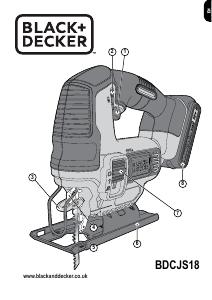


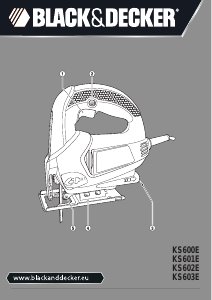

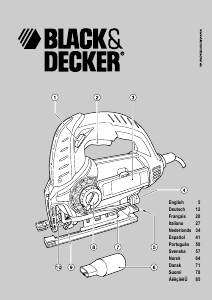
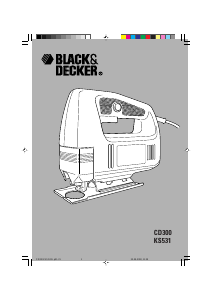

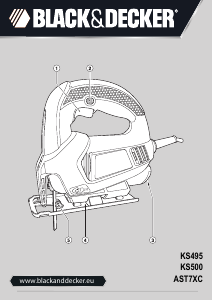
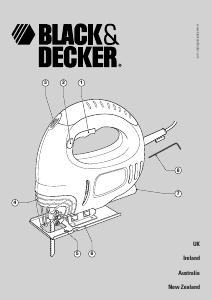

Join the conversation about this product
Here you can share what you think about the Black and Decker BDCJS18 Jigsaw. If you have a question, first carefully read the manual. Requesting a manual can be done by using our contact form.